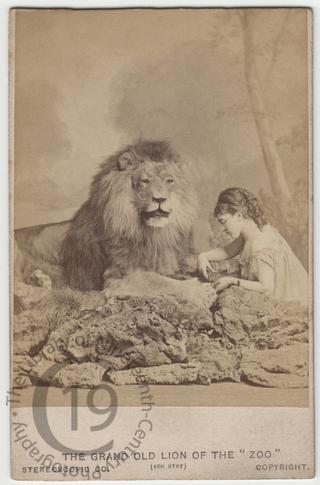
The Old Lion of the Zoo
A carte-de-visite showing London Zoo’s famous attraction after he had died and received the attentions of the country’s premier taxidermist.
An extensive printed caption verso reads: ‘The magnificent old Lion of the “Zoo,” that for ten years was one of the principal attractions and favorites of the Gardens – The Lion that Landseer so often painted and modelled and whose portrait with slight variations forms the colossal type of the British Lion in Trafalgar Square, and whose death took place it may be remembered some months ago, has by the new, ingenious, and really artistic process of Messrs. WARD & Co., been preserved to the nation on a form which is singularly spirited and lifelike, and with studious fidelity to his anatomical structure. This will be seen at once by examining the annexed Photograph. It may be mentioned that it took six men to place the “King of the Beasts” in the studio of the Company.’ The caption concludes with the lion’s dimensions, which were apparently 9ft 1in from nose to tip of tail.
Photographed by the London Stereoscopic and Photographic Company.
The image was entered at Stationers’ Hall, an essential part of the copyrighting process, on 17 August 1872, along with two other photographs taken on the same occasion, one showing the woman seen here seated on the lion’s back and another showing the lion with ‘a sleeping child.’ This photograph shows 'the female figure apparently cutting his nails.'
According to a contemporary report: ‘Some time ago we stated that this old favourite, which for 10 years and until his death was one of the principal attractions of the gardens – the lion that Landseer so often painted, and served as a model for colossal lions in Trafalgar-square – had, by the highly ingenious process of Messrs Ward and Co., been preserved in a life-like form. Since then an excellent photograph of the noble animal has been taken by the London Stereoscopic Company, and copies of it can be obtained of them, as well as the shop of Messrs Ward and Co., 158, Piccadilly, where the lion occupying the whole of the window forms a novel and attractive picture to passers by’ (Morning Post, 25 September 1872).
Code: 127463




